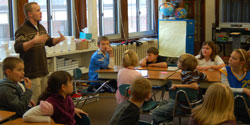You reached this page through the archive. Click here to return to the archive.
Note: This article is over a year old and information contained in it may no longer be accurate. Please use the contact information in the lower-left corner to verify any information in this article.
'Eco-logic' class takes lessons into community
December 21, 2009
After spending a semester studying the consequences of consumption — including participating in a weeklong project that challenged them to live a “zero-waste” lifestyle — students in one St. Olaf class took the lessons they learned into the community.
 |
| Adam Sveum '13 asks fifth-grade students at St. Dominic Elementary School to think about ways they can reduce waste. Sveum worked with the students as part of a St. Olaf course on consumption and its consequences. |
As part of a course titled “Eco-logic: Consumption and its Consequences,” taught by Visiting Assistant Professor of Interdisciplinary Studies Susannah Shmurak, a group of Oles spent a recent afternoon working with students and staff at St. Dominic Elementary School in Northfield. While some of the St. Olaf students met with staff members to discuss measures the school could take to become more environmentally friendly, others worked with young students on activities designed to teach them how to reduce waste, make sustainable food choices, and use less energy.
In one activity, Oles taught kindergarteners a song to remind them to turn off the faucet after washing their hands and avoid wasting paper towels. Other activities used coloring projects and a game of jeopardy to teach students in other grades which food choices are better for the environment and simple ways they can reduce their energy consumption.
“We wanted to come up with something informative, yet engaging for each age group,” says Sarah Phillips ’13. “I was amazed at how much the students already knew. They had some very insightful ideas about how they could be less wasteful.”
While their classmates worked with young students at St. Dominic, Janae Kirsch ’13 and Aron Block ’13 drew up a list of cleaning chemicals used at the school and spoke with the staff on which were most harmful and how they could be substituted with more eco-friendly choices.
A class on consumption
Working with students and staff at St. Dominic Elementary School was just one project that the 17 students in Shmurak’s class worked on throughout the semester. The class is designed to help students understand how personal actions and decisions affect the environment.
“As more of us learn the effects of our actions and teach others, the way we do things — individually and as a society — will slowly change and lead to a more sustainable world,” Shmurak says.
 |
| Anthony Parks '12 talks to kindergarteners at St. Dominic Elementary School about sustainable food choices as they color pictures of farms and food. |
Earlier in the semester, a number of students participated in the weeklong, nationwide No Impact Project. Designed by Colin Beaven, the “No Impact Man” who lived a “zero-waste” lifestyle with his family in New York City for one year, the project forces participants to take a closer look at their lifestyle during one week of low-impact living.
Each day of the week has a different focus: participants eliminate all unnecessary consumption on Sunday and all unnecessary waste on Monday, cut back on automated transportation on Tuesday, eat only locally grown foods on Wednesday, reduce or eliminate electricity use on Thursday and water use on Friday, and on Saturday take a pro-active approach to environmental sustainability by volunteering, donating to an environmental organization, or educating others. (While St. Olaf students participated in a national weeklong event in October, the project can be conducted individually any week of the year.)
Making an impact with no impact
Living on campus made participating in the No Impact Project easier than it might otherwise have been, several students noted, although they still learned valuable lessons along the way. Eating local foods, for instance, wasn’t difficult for Dana Dass ’13 because much of the food in St. Olaf’s Stav Hall is locally grown. Reducing automated transportation was also easy, says Annika Bergen ’13, because students living on a college campus have little need to go far.
Reducing electricity use, however, was much harder for students, who found it difficult to pull away from devices like laptops and cell phones — even for a day. Reducing water use was also difficult, Bergen says. “I’ve become so accustomed to having my warm morning shower, and having to use a ‘sponge bath’ method was really unappealing to me,” she says.
Dass found other ways to reduce her electricity and water use by pulling out unused plugs, reading by the window instead of using a lamp, and turning the water off while brushing her teeth, washing her hands, and doing the dishes. Her biggest challenge was her habit of grabbing bag lunches on the go. Not only do the lunches create excessive waste with their cling wrap, chip bags, and mayonnaise packages, but much of the food included isn’t locally grown.
Since completing the experiment and examining issues of consumption in Shmurak's course, both have continued to use sustainable techniques in their daily lives. Dass is making a concerted effort not to consume food in individually wrapped packages, Bergen is “always turning off lights and pulling out unused plugs,” and both continue to take a hand towel to the bathroom. “This experiment made me so much more aware that every little thing I do has an impact on the planet,” says Dass.
Bergen agrees that it was an eye-opening experience. “Although I knew I wasn’t living a very sustainable lifestyle, this experiment helped me realize where I was being wasteful and ways in which I could reduce my consumption.”
